Solar battery installation inspections are essential. They ensure systems are safe, compliant, and function optimally. While my previous blog outlined the common defects found during battery inspections, this instalment will focus on harder-to-spot issues that are often missed.
As a licensed electrical inspector, I have the training to spot these hidden problems — defects not always obvious but vital for the safety and operation of solar battery installations. Identifying and correcting these issues is crucial as they can significantly influence the system’s performance and safety.
Let’s examine some of these less noticeable defects that every installer and inspector needs to be aware of.
Insufficient Mechanical Protection for Cables
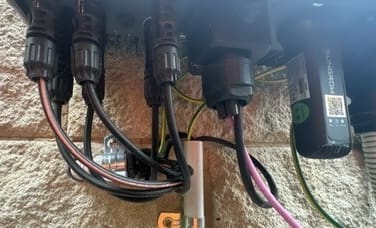
Bad: The battery cables (3rd input from the left) are not protected.
Overview of the Issue
In the setup of solar battery systems, the physical protection of cables is not merely a requirement but a necessity for safety. Cables without sufficient mechanical protection are vulnerable to damage from environmental factors and routine maintenance activities. This exposure not only risks the integrity of the cable but can also lead to serious safety hazards, including short circuits and fires.
Standards Cited
This issue is addressed under AS/NZS 5139:2019 CL 5.3.1.4.3, which mandates that cables in certain configurations must be adequately protected to prevent physical damage.
5.3.1.4.3 Mechanical Protection
All cables that exit a pre-assembled battery system without internal overcurrent protection shall be mechanically protected by at least medium duty conduit or equivalent protection up to overcurrent protection device.
Recommendation
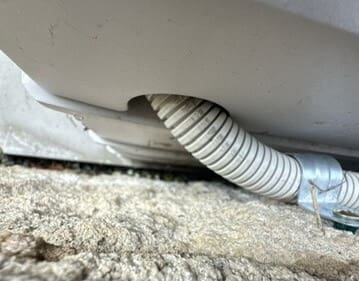
Good: Cables are protected all the way to the (hidden) battery terminals.
To shield cables effectively, I recommend protective conduits or cable covers. This can be a challenge when it comes to aesthetics, but cable trays or custom-made flashing not only protect but also look great.
However, if opting for metal flashing, it’s crucial to smooth any sharp edges.
Inadequate Isolation of Battery/Inverter Systems
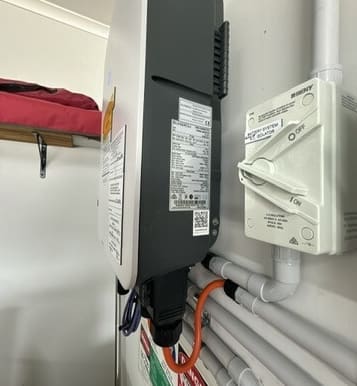
Bad: Backup circuits are installed, but no isolator is adjacent to the system.
Overview of the Issue
Proper isolation of battery and inverter systems is critical for safety and maintenance when batteries are installed in locations not immediately adjacent to the main switchboard. Effective isolation allows the system to be safely disconnected, ensuring that maintenance personnel or inspectors are not exposed to live circuits during work and complicate both emergency responses and routine checks.
Standards Cited
AS/NZS 4777.1 Cl 3.4.3 specifies the requirements for isolation devices in solar energy systems, ensuring that the main and backup circuits can be effectively isolated when needed.
Recommendation
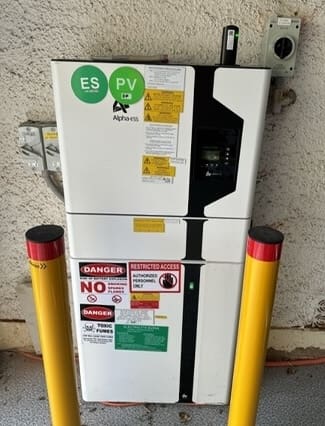
Good: On the left are 2 x AC isolators, one for the backup circuits.
It’s also important to ensure the isolator is easily accessible and clearly marked to facilitate quick action in an emergency.
Earthing and Bonding Concerns
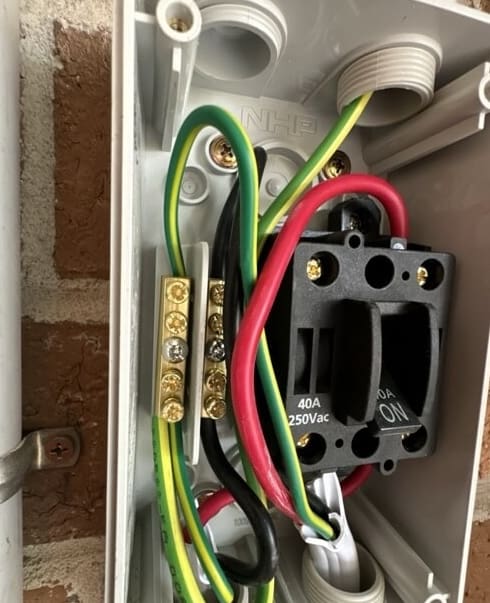
Bad: A 4mm² cable connected to a 2.5mm² earthing conductor back to the switchboard – not thick enough.
Overview of the Issue
Proper earthing and bonding are vital in any electrical installation, but they become even more crucial in higher-voltage systems 1. Inadequate earthing can lead to problems, including electrical shocks, system instability, and fire hazards. For solar battery systems, it is critical that the bonding conductors are sufficiently robust; a minimum cross-sectional area of 6mm² is required, not the 4mm² commonly used in domestic solar arrays.
Standards Cited
The importance of correct earthing practices is underscored in AS/NZS 5139:2019 CL 5.3.1.7.3 & 5.3.1.7.4, which dictate the specifications for earthing and bonding in solar installations.
Recommendation
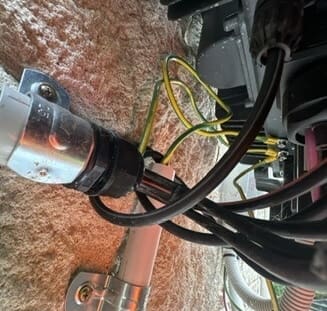
Good: All earthing provided to the battery is 6mm².
To ensure safety and compliance, it is imperative that all metal enclosures associated with the battery system are properly bonded and earthed. Installers should strictly adhere to the manufacturer’s guidelines for termination and avoid shortcuts such as self-drilling screws, which may compromise the integrity of the earth connection. Proper termination ensures a secure and reliable connection that meets safety standards and withstands environmental stresses, safeguarding against electrical faults.
Insulation Deficiencies in Cabling
Overview of the Issue
In our world of solar battery installations, the integrity of cabling insulation is critical to protecting everyone. Insufficient insulation can expose systems to severe electrical hazards, including short circuits and fire risk. It’s crucial that all cabling, especially those leading to battery terminals, is double insulated to prevent these potential threats.
Standards Cited
This issue is governed by AS/NZS 5139:2019 CL 5.3.1.4.2, which stipulates the requirements for cable insulation in battery systems.
Recommendation
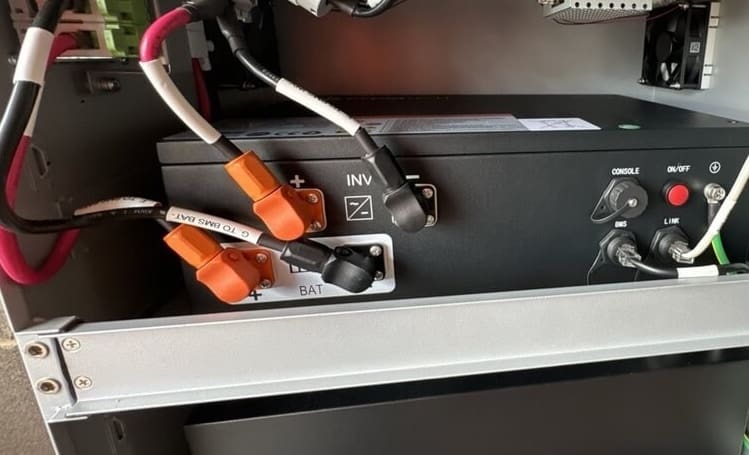
Good: Double insulation maintained all the way to the battery terminals.
To maintain safety and compliance, a rigorous inspection regimen should be implemented to check for insulation integrity. Any cables found with insufficient insulation should be replaced promptly. When installing new cables, ensure they are double-insulated throughout, extending up to the battery terminals. This meets the standard requirements and significantly reduces the risk of electrical failures. It’s advisable for installers to familiarise themselves with the types of insulation suitable for high-voltage setups and to use only products certified for such applications.
Conclusion
The less obvious aspects of battery installation safety are important yet easier to overlook. However, these aspects are essential for long-term reliability and safety. As discussed, proper cable protection, correct isolation of battery systems, secure earthing and bonding, and adequate cable insulation are key areas that need careful attention.
For those working in solar installation and inspection, paying close attention to these details is important to prevent failures and ensure the systems we install perform well and are safe.
Keeping up with regular checks, staying updated with the latest standards, and continuing our education in safety practices all have their place. As solar technology advances, we can ensure our installation practices meet the highest standards. It’s our responsibility to make sure every part of the installation is done right for the benefit of our clients and the environment.
Let’s keep pushing for excellence in every part of our work, ensuring that our solar and battery installations are as safe as possible.
Footnotes
- exceeding DVC-A ↩

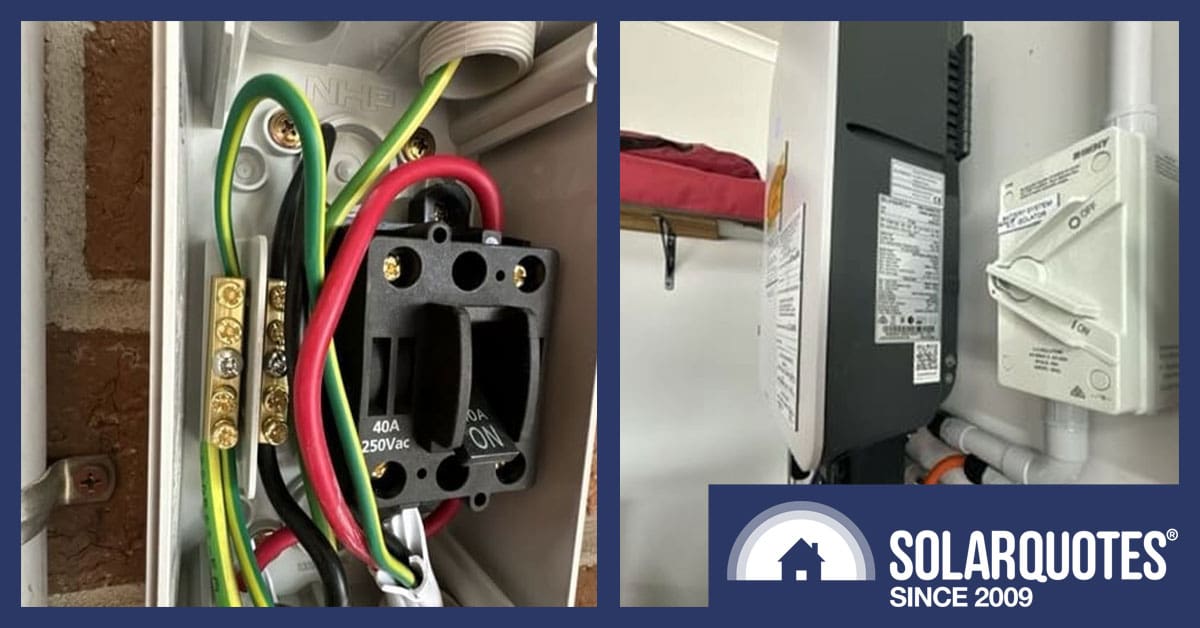
 RSS - Posts
RSS - Posts



Excellent overview of common mistakes with battery installations.
I’m aware of many LV battery systems that have no easy way to mechanically protect the d.c. cables leaving the battery system. I have spoken to several manufacturers about their designs but often this falls on deaf ears as they say, “we’ve had no problems with this arranagement before”.
Hopefully a more thorough enforcement of AS/NZS 5139:2019 Cl. 5.3.1.4.3 will sharpen their awareness.
Keep up the good work Pat.
So are you saying that AS/NZS 5139:2019 CL 5.3.1.4.2 applies to 48V systems? And that they require double insulated battery cables?
No.
As per Safe Work Australia and AS/ NZS 3000:
“Extra low voltage means voltage that does not exceed 50 volts alternating current (50 V a.c.) or 120 volts ripple-free direct current (120 V ripple-free d.c.).
Low voltage means voltage that exceeds extra-low voltage and does not exceed 1000 volts alternating current (1000 V a.c.) or 1500 volts direct current (1500 V d.c.).
High voltage means voltage that exceeds low voltage.”
It would be better to talk of Decisive Voltage Classification (DVC), a 48V DVC-A system does not require mechanically protected cables.
Pat, by my understanding, this:
“exit a pre-assembled battery system without internal overcurrent protection”
could only be for a seperate bank of seperate batteries/cells?
..but doesn’t apply to most BESS systems, because the BMS (which is in the battery half of the ESS), does have output MOSFETS or relays, with current monitoring?
P.S. I’m still trying to work out what “adjacent” means in terms of isolators.
On the same wall? Within 1meter? Three steps away on the other side of a freestanding brick wall?
Hi Pat, are you able to share a clause regarding the RCD requirement for any circuits designated backup? Wondering if this means in the whole home backup scenario becoming popular all sub circuits would need to be RCD protected?
I currently have a 20 panel ~5KW system at my home in Qld.
But as I wanted to disconnect my existing (expensive) AC pool pump from the mains/solar, I have installed a separate solar inverter and (4) panel array mounted nearby to exclusively feed a 900W DC swimming pool pump system I bought. (Working very well for the last two years now)
I have earthed the panels and inverter to a separately driven-in 1.5m copper earth stake using a copper earth clamp near the concrete pool, using 6mm single core copper earth cable. I have also installed an Isolation switch to disconnect the DC from the panels to the inverter/controller
As the pool itself is electrically bonded to the pool rebar (before the concrete was poured) and connected to the house earth through the mains cabling (earth impedance tested by the pool company electrician at the time), am I creating a problem with a potential voltage difference between the panels I installed and the pool earth?
If so, should I disconnect my earth and connect the currently separate panel system to the building earth?
Any help/advice greatly appreciated
Hi Neil,
I can’t comment without seeing the installation & knowing if what you’re playing with is below DVC “a”
If it’s above 50vac or 120vdc then it’s licenced electricians work, DIY is illegal.
My advice is that you wouldn’t want two pumps side by side with different earth potential, but I can’t offer instruction other than to get a licenced sparky to assess it.
https://www.solarquotes.com.au/blog/diy-wiring-danger-australia/
Thanks Anthony
The DC voltage from the 4 panel string (at the pump controller) is less than 120v DC, and while I do have two pumps physically side by side, one is only ever connected to its supply at a time in an A OR B arrangement, with two valves on the PVC water pipes used to switch flow to the pool to either one or the other pump (the original 240V pump is there for a back-up only).
That is, the 900W DC Pump is running most of the time and the 240V pump is physically unplugged from the mains. If the DC pump fails I switch the flow to the 240v pump and disconnect the DC pump before plugging in the mains power unit.
As far as the earthing goes, the ‘solar earth’ from my earth stake only connects to the controller and not to the adjacent mains-driven pump, which connects back to the house mains earth. So far they are both isolated.
That said, and I take your point, I probably need to get a solar-capable sparky in to advise.
Cheers
Neil
No worries Neil,
I’m led to believe that solar pool pumps are excellent but I don’t have a pool myself.
As a licenced spark in highly regulated Australia I can’t afford to offer advice without seeing it myself; and similarly you don’t want to be denied insurance for DIY electrical. I posed your question to a few electricians forums, because I thought it was interesting, pool earthing is often a hot topic, and some trades are too embarrassed to ask… but they’ll learn from reading.
The resounding answer was “get a sparky” because while some people decry the nanny state, nobody wants to be on the hook for bad advice.
Hi Anthony
Just wondering about battery installation locations , i have had a couple of installers look at my place with different points of view concerning the rules , it relates to whether the other side of the “wall is habitable or not “its a garage wall that opens into the house but on the other side is a alfresco area (open Area but enclosed ) also as the garage wall is wood panelled lined 1 says that they have to put a fire resistant sheet behind battery the other says not as it’s not a habitable area on the other side . i am confused
Also the other place the battery can go is apparently too close to an A/c unit about 450mm , but you can but the battery up against a fridge in the garage which is ok but both are electric powered , can you help me
Hi John,
Hard for me to judge from a distance but see what you can find here :
https://www.solarquotes.com.au/blog/battery-installation-locations/
Any restriction on the surface type when mounting an inverter? The existing Fronius is on plywood and wondering if a new unit has to be ona fire resistant surface
Hi Andrew,
Fronius fan cooled goodness won’t have any problems with heat on any surface, though I have seen some passive cooled (cheap chinese) inverters that discolour paint on the wall.
Fireproof cement sheet is called for in battery installations.
https://www.solarquotes.com.au/blog/battery-installation-locations/